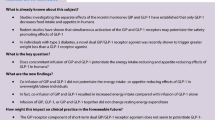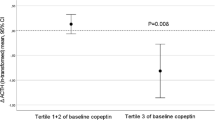Abstract
Purpose
Glucagon-like peptide-1 (GLP-1) receptor agonists (RA) reduce appetite and energy intake. Recent findings from animal studies suggest a role of GLP-1 in drinking and water homeostasis. We aimed to elucidate whether GLP-1 RA reduce fluid intake in healthy volunteers.
Methods
Double-blind, randomized, placebo-controlled, crossover study. 20 healthy volunteers received dulaglutide 1.5 mg and placebo (0,9% sodium chloride) subcutaneously once weekly for 3 weeks. At the end of each treatment period, participants attended an 8-h evaluation visit, during which they were requested to eat two standardized meals and to drink water ad libitum. The primary outcome was the total fluid intake (ml) during the evaluation visit.
Results
Mean [SD] age of participants (60% female) was 27 [9.2] years. All but four participants drank less on dulaglutide versus placebo treatment despite identical food intake. The median [IQR] difference of fluid intake on dulaglutide compared to placebo treatment was −100 ml [−400–0]. Median [IQR] total fluid intake was 1300 ml [888–1600] versus 1600 ml [1000–1720], on dulaglutide and placebo treatment, p = 0.06. Median [IQR] 24-h urine output was reduced in dulaglutide versus placebo-treated participants: 1250 ml [975–2080] versus 1680 ml [1400–2040], p = 0.04. Median serum sodium levels were 140 mmol/L on both visits and no difference in thirst perception was noted.
Conclusions
GLP-1 RA such as dulaglutide seem to modulate fluid balance in humans. This leads us to speculate that GLP-1 RA may be an interesting therapeutic options for patients with excessive drinking behavior e.g., primary polydipsia.



Similar content being viewed by others
References
P.J. Larsen, M. Tang-Christensen, J.J. Holst, C. Orskov, Distribution of glucagon-like peptide-1 and other preproglucagon-derived peptides in the rat hypothalamus and brainstem. Neuroscience 77(1), 257–270 (1997)
I. Merchenthaler, M. Lane, P. Shughrue, Distribution of pre-pro-glucagon and glucagon-like peptide-1 receptor messenger RNAs in the rat central nervous system. J. Comp. Neurol. 403(2), 261–280 (1999)
C. Herrmann, R. Goke, G. Richter, H.C. Fehmann, R. Arnold, B. Goke, Glucagon-like peptide-1 and glucose-dependent insulin-releasing polypeptide plasma levels in response to nutrients. Digestion 56(2), 117–126 (1995)
M. Gutniak, C. Orskov, J.J. Holst, B. Ahren, S. Efendic, Antidiabetogenic effect of glucagon-like peptide-1 (7-36)amide in normal subjects and patients with diabetes mellitus. N. Engl. J. Med. 326(20), 1316–1322 (1992). https://doi.org/10.1056/NEJM199205143262003
G.P. Smith, J. Gibbs, Brain-gut peptides and the control of food intake. Adv. Biochem. Psychopharmacol. 28, 389–395 (1981)
J. Gibbs, G.P. Smith, Satiety: the roles of peptides from the stomach and the intestine. Fed. Proc. 45(5), 1391–1395 (1986)
M.D. Turton, D. O’Shea, I. Gunn, S.A. Beak, C.M. Edwards, K. Meeran, S.J. Choi, G.M. Taylor, M.M. Heath, P.D. Lambert, J.P. Wilding, D.M. Smith, M.A. Ghatei, J. Herbert, S.R. Bloom, A role for glucagon-like peptide-1 in the central regulation of feeding. Nature 379(6560), 69–72 (1996). https://doi.org/10.1038/379069a0
A. Andersen, A. Lund, F.K. Knop, T. Vilsbøll, Glucagon-like peptide 1 in health and disease. Nat. Rev. Endocrinol. 14(7), 390–403 (2018). https://doi.org/10.1038/s41574-018-0016-2
J.P. Gutzwiller, J. Drewe, B. Göke, H. Schmidt, B. Rohrer, J. Lareida, C. Beglinger, Glucagon-like peptide-1 promotes satiety and reduces food intake in patients with diabetes mellitus type 2. Am. J. Physiol. 276(5), R1541–R1544 (1999). https://doi.org/10.1152/ajpregu.1999.276.5.R1541
J.P. Gutzwiller, B. Göke, J. Drewe, P. Hildebrand, S. Ketterer, D. Handschin, R. Winterhalder, D. Conen, C. Beglinger, Glucagon-like peptide-1: a potent regulator of food intake in humans. Gut 44(1), 81–86 (1999)
D.G. Bichet, Vasopressin and the Regulation of Thirst. Ann. Nutr. Metab. 72(Suppl 2), 3–7 (2018). https://doi.org/10.1159/000488233
N.J. McKay, S.E. Kanoski, M.R. Hayes, D. Daniels, Glucagon-like peptide-1 receptor agonists suppress water intake independent of effects on food intake. Am. J. Physiol. Regul. Integr. Comp. Physiol. 301(6), R1755–R1764 (2011). https://doi.org/10.1152/ajpregu.00472.2011
Team, R.C.: R: A Language and Environment for Statistical Computing. (R Foundation for Statistical Computing, Vienna, Austria, 2017)
J.P. Gutzwiller, P. Hruz, A.R. Huber, C. Hamel, C. Zehnder, J. Drewe, H. Gutmann, Z. Stanga, D. Vogel, C. Beglinger, Glucagon-like peptide-1 is involved in sodium and water homeostasis in humans. Digestion 73(2-3), 142–150 (2006). https://doi.org/10.1159/000094334
J. Skov, A. Dejgaard, J. Frøkiær, J.J. Holst, T. Jonassen, S. Rittig, J.S. Christiansen, Glucagon-like peptide-1 (GLP-1): effect on kidney hemodynamics and renin-angiotensin-aldosterone system in healthy men. J. Clin. Endocrinol. Metab. 98(4), E664–E671 (2013). https://doi.org/10.1210/jc.2012-3855
J. Skov, Effects of GLP-1 in the kidney. Rev. Endocr. Metab. Disord. 15(3), 197–207 (2014). https://doi.org/10.1007/s11154-014-9287-7
J. Skov, M. Pedersen, J.J. Holst, B. Madsen, J.P. Goetze, S. Rittig, T. Jonassen, J. Frøkiaer, A. Dejgaard, J.S. Christiansen, Short-term effects of liraglutide on kidney function and vasoactive hormones in type 2 diabetes: a randomized clinical trial. Diabetes Obes. Metab. 18(6), 581–589 (2016). https://doi.org/10.1111/dom.12651
M.J. McKinley, A.K. Johnson, The physiological regulation of thirst and fluid intake. News Physiol. Sci. 19, 1–6 (2004)
M. J. McKinley, D.A. Denton, P.J. Ryan, S.T. Yao, A. Stefanidis, B.J. Oldfield, From sensory circumventricular organs to cerebral cortex: Neural pathways controlling thirst and hunger. J. Neuroendocrinol. e12689 (2019). https://doi.org/10.1111/jne.12689
V. Augustine, S.K. Gokce, S. Lee, B. Wang, T.J. Davidson, F. Reimann, F. Gribble, K. Deisseroth, C. Lois, Y. Oka, Hierarchical neural architecture underlying thirst regulation. Nature 555(7695), 204–209 (2018). https://doi.org/10.1038/nature25488
P. Saker, M.J. Farrell, G.F. Egan, M.J. McKinley, D.A. Denton, Influence of anterior midcingulate cortex on drinking behavior during thirst and following satiation. Proc. Natl. Acad. Sci. USA 115(4), 786–791 (2018). https://doi.org/10.1073/pnas.1717646115
D.A. Denton, M.J. McKinley, R.S. Weisinger, Hypothalamic integration of body fluid regulation. Proc. Natl. Acad. Sci. USA 93(14), 7397–7404 (1996)
C. Sailer, B. Winzeler, M. Christ-Crain, Primary polydipsia in the medical and psychiatric patient: characteristics, complications and therapy. Swiss Med. Wkly. 147, w14514 (2017). https://doi.org/10.4414/smw.2017.14514
C.O. Sailer, B. Winzeler, N. Nigro, I. Suter-Widmer, B. Arici, M. Bally, P. Schuetz, B. Mueller, M. Christ-Crain, Characteristics and outcomes of patients with profound hyponatraemia due to primary polydipsia. Clin. Endocrinol. (Oxf) 87(5), 492–499 (2017). https://doi.org/10.1111/cen.13384
B. Dundas, M. Harris, M. Narasimhan, Psychogenic polydipsia review: etiology, differential, and treatment. Curr. Psychiatry Rep. 9(3), 236–241 (2007)
J.A. Engel, E. Jerlhag, Role of appetite-regulating peptides in the pathophysiology of addiction: implications for pharmacotherapy. CNS Drugs 28(10), 875–886 (2014). https://doi.org/10.1007/s40263-014-0178-y
J.R. Barson, I. Morganstern, S.F. Leibowitz, Similarities in hypothalamic and mesocorticolimbic circuits regulating the overconsumption of food and alcohol. Physiol. Behav. 104(1), 128–137 (2011). https://doi.org/10.1016/j.physbeh.2011.04.054
E. Alvarez, I. Roncero, J.A. Chowen, B. Thorens, E. Blazquez, Expression of the glucagon-like peptide-1 receptor gene in rat brain. J. Neurochem. 66(3), 920–927 (1996)
W. Glaesner, A.M. Vick, R. Millican, B. Ellis, S.H. Tschang, Y. Tian, K. Bokvist, M. Brenner, A. Koester, N. Porksen, G. Etgen, T. Bumol, Engineering and characterization of the long-acting glucagon-like peptide-1 analogue LY2189265, an Fc fusion protein. Diabetes Metab. Res. Rev. 26(4), 287–296 (2010). https://doi.org/10.1002/dmrr.1080
K. Hunter, C. Hölscher, Drugs developed to treat diabetes, liraglutide and lixisenatide, cross the blood brain barrier and enhance neurogenesis. BMC Neurosci. 13, 33 (2012). https://doi.org/10.1186/1471-2202-13-33
K.P. Kinzig, D.A. D’Alessio, R.J. Seeley, The diverse roles of specific GLP-1 receptors in the control of food intake and the response to visceral illness. J. Neurosci. 22(23), 10470–10476 (2002)
Acknowledgements
We thank our volunteers for the participation in our study. In addition, we thank the support staff, study and laboratory personnel at the University Hospital Basel, especially Nina Hutter, Cemile Bathelt, Céline Bürgi, Karin Wild und Silke Purschke for their most helpful support during the study.
Funding
The study was investigator initiated and was supported by a grant from the Swiss National Foundation to M. Christ-Crain (SNF-162608) and the University Hospital Basel, Switzerland.
Author information
Authors and Affiliations
Corresponding author
Ethics declarations
Conflict of interest
The authors declare that they have no conflict of interest.
Ethical approval
The study protocol and study medication were approved by both the local ethic committee and the national agency for the authorization and supervision of therapeutic products (Swissmedic). All procedures were in accordance with the 1964 Helsinki declaration and its later amendments. Written informed consent was obtained from all study participants.
Additional information
Publisher’s note Springer Nature remains neutral with regard to jurisdictional claims in published maps and institutional affiliations.
Supplementary information
Rights and permissions
About this article
Cite this article
Winzeler, B., da Conceição, I., Refardt, J. et al. Effects of glucagon-like peptide-1 receptor agonists on fluid intake in healthy volunteers. Endocrine 70, 292–298 (2020). https://doi.org/10.1007/s12020-020-02394-2
Received:
Accepted:
Published:
Issue Date:
DOI: https://doi.org/10.1007/s12020-020-02394-2




